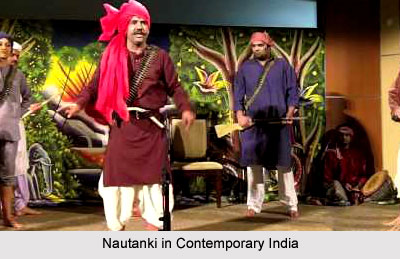 Nautanki in contemporary India is practised mostly in northern part of the country and presently it is performed in other parts as well. However, presently Nautanki is experiencing a dialectical tension. Alongside this form of theatre holds a crucial place in people`s collective imagination, and on the other hand it is also struggling to deal with changing audience aspirations moulded by cinema and television.
Nautanki in contemporary India is practised mostly in northern part of the country and presently it is performed in other parts as well. However, presently Nautanki is experiencing a dialectical tension. Alongside this form of theatre holds a crucial place in people`s collective imagination, and on the other hand it is also struggling to deal with changing audience aspirations moulded by cinema and television.
Some of the performing troupes have utilized Nautanki to support, promote and spread social change and development. Brij Lok Madhuri (BLM) is one such troupe which has gained popularity. This group was founded and promoted by popular Nautanki singer and actor Pandit Ram Dayal Sharma in the 1970s to promote the use of folk forms for purposive social change. Nautanki, as a community art form, is more real and live art form than video and television can ever be, and also closer to the culture of rural and semi-rural people.
Working in collaboration with Government of India and Johns Hopkins Bloomberg School of Public Health Centre for Communication Programs from 1999 to 2004, Brij Lok Madhuri (BLM) created new Nautanki and other folk form scripts on pro-social messages such as small family size, women`s empowerment, dowry eradication, and HIV-AIDS prevention. BLM trained over 150 folk troupes to perform these scripts in north Indian villages.
Recently, the Nautanki performance has become in foreign soil as well like in USA where people with fondness for drama and theatre have joined hands for performance of Nautanki. The bilingual nature of the script (it is both in Hindi and English) protects the traditional operatic and artistic elements of Nautanki while effectively communicating the story and contemporary social issue to a diverse audience. A contemporary Nautanki such as Mission Suhani involving a global social issue helps Nautanki update itself to emerging issues in contemporary society in India and around the world



















